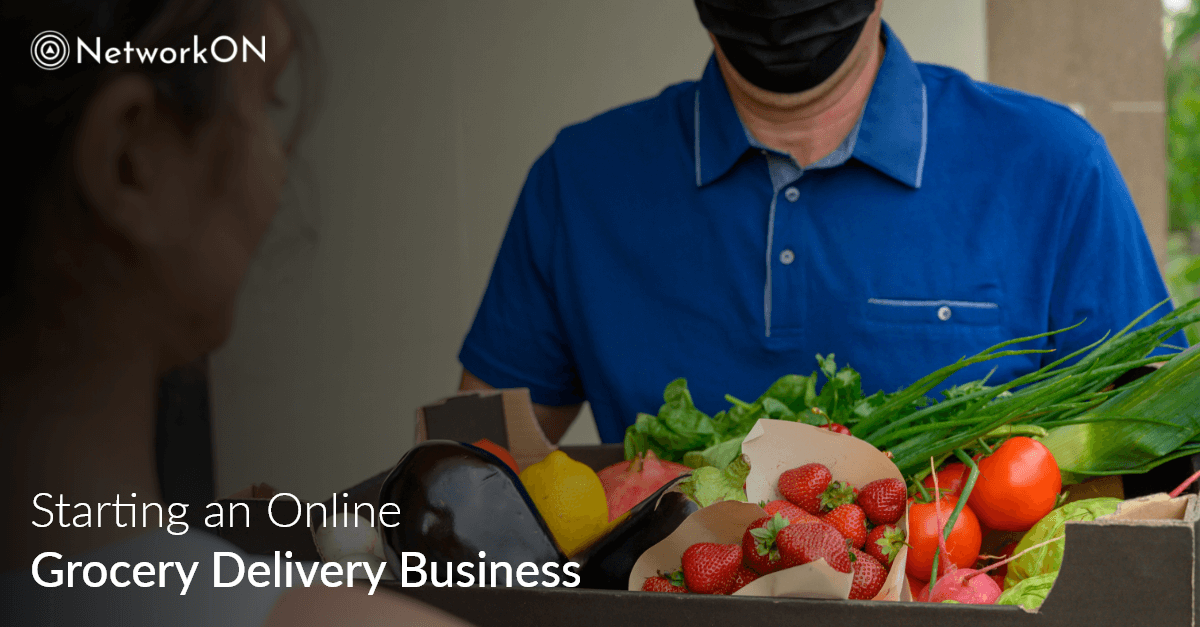Table of Contents
The online grocery delivery business is not a new concept; however, it has only achieved its full potential in recent times with the onset of the Covid-19 pandemic, resulting in people stockpiling groceries and supplies in full swing through online grocery delivery platforms.
Before we begin how you can set up an online grocery store for yourself, let’s look at the rise of this growing economy and why it’s a great idea to invest in online grocery delivery software in 2021.
The Rise of Grocery Delivery Economy
Even as the global economy was slowed by the COVID-19 pandemic, online grocery service is one domain that has catapulted to ever-higher numbers. The impact is visible from the fact that even after the lockdowns have eased off, people are in no rush to return to the brick and mortar stores.
The surge in demand for online grocery delivery platforms occurred after the COVID-19 pandemic that pushed consumers to opt for a safe and convenient way of getting grocery items.
With the growing number of online stores offering lucrative features, consumers have been accustomed to a variety of incentives and options to order groceries through mobile and web apps.
Even though a large share of these consumers were first-time buyers during the pandemic, now they have chosen this mode of grocery shopping for convenience.
Apart from the large influx of new consumers, the growth in the online grocery delivery business is also due to a large number of frequent orders. Customers are now ordering online not only to stock up for a long trip or holiday but also in the form of smaller grocery runs—to get ingredients of a special recipe or to get quickly depletable items like milk, bread, and other staple items.
Given the newfound synergy between online grocery delivery apps and consumers, the collaboration has created a new niche for a successful investment. Now that we have figured out why the online grocery economy is still rising let’s discuss how you can successfully start an on-demand grocery delivery business.
How to Start an On-Demand Grocery Delivery Business?
Since the market has opened up to the on-demand grocery delivery business, it’s a great opportunity for store owners or budding entrepreneurs to set foot in this direction.
To help you through, we have created the basic process flow of an online grocery delivery business.
Forming a legal entity
The primary business establishment step is registering the company with an authentic registration authority. You will also need to pay sales and services tax for the online sale of groceries, for which appropriate registration is required.
Finalizing a business model
An online grocery delivery business plan involves picking up grocery items from a vendor and delivering it to a consumer’s doorstep. However, between this there can be several ways an on-demand grocery delivery model works:
Tie-up with offline grocery vendors
In this model, you tie up with offline grocery vendors who don’t offer online delivery services. You will build an online grocery marketplace enlisting all the vendors in a specific area. The consumers will use your marketplace to choose the vendor nearest to their locations and get the items delivered to their doorstep.
Listing items on a website
In this service model, you will enlist different grocery items on a website where people can choose the item they need and its quantity. You will get those items from a vendor and deliver them to your customers.
Starting an online delivery service for your offline grocery store
This service model is specifically for offline grocery store owners. In this model, you will have to manage all three aspects of the service: warehousing, logistics, and delivery.
Selecting a Readymade Grocery Delivery Solution
If you’re starting an online grocery service from scratch, you would need help from market analysts, design specialists, business experts and professionals to get involved at different stages of the development process.
While this sounds hectic, the best solution is to connect with a team of experts who can offer a readymade online grocery delivery software solution, which you can use to build your business. The other benefit of selecting a ready-made solution is the number of options you get in terms of customizations, on-boarding assistance, and business model configuration.
Choosing a Revenue Model
There are different ways you can choose a business model to earn revenue. Each method has its benefits, so it’s important to choose what seems best for your business.
Commissions
There are two ways to charge commissions in an online delivery service:
- Commission on each transaction: When a vendor makes a sale, a small share is given to the marketplace owner as a commission for using the portal.
- Commission on delivery: This involves charging the buyer and the driver with a small amount on every purchase and delivery.
Vendor Subscription Fees
This model works like a membership fee, in which vendors pay you a fixed subscription fee for a fixed period. It is a good alternative when the vendors don’t want to pay you a commission on sales.
On-site Promotion
It involves allowing vendors to display their personalized ads and banners on the platform’s website. You can charge the sellers for the space and number of campaigns they run. Plus, you can also get revenue from displaying independent products as well.
Key Features of Grocery Delivery Software
An online grocery delivery management system needs to have features that add to the convenience and utility of the consumers. Here’s a list of must-have features that can be essential for the success of your online grocery delivery business.
Route Optimization
Route Optimization identifying the most cost-effective and quickest route for drivers to take to deliver a package from the transportation hub to the end customer. With a proper route optimization plan, your business could save up to 20 to 40 percent on fuel costs
It does not necessarily mean finding the shortest route but focuses more on minimizing the total driving time while making a certain number of stops. It also includes variables like delivery time windows, vehicle load capacity, driver proximity and schedule, traffic congestion, etc.
Fleet Management
Fleet management is handy for providing analytics and reports to help managers evaluate fuel expenditure in a specific route. It also identifies drivers who drive more miles in a route than required.
With grocery orders flooding in every hour, assigning deliveries quickly is essential. Hence, fleet tracking helps import addresses and prepare an optimal delivery schedule for your fleet. It also helps managers to allocate delivery schedules based on driver skills and location proximity.
In-app Notifications
In-app notifications are types of messages that you can send to users within the app. It helps you direct your customers towards points of interest like discount offers, items, and any new features you have added to your app.
Since in-app notifications are built into the app experience, they’re not generally ignored by your customers and helps you increase targeting.
Real-time Tracking
Real-time delivery is critical for on-demand delivery platforms as it allows managers to have complete visibility on their delivery personnel.
With GPS tracking of drivers, you can know the location of the driver, the status of the assignment, and information such as idle time, transit distances, and more.
It also allows your customers to know where their orders are in real-time, and get accurate ETAs with updates about any unexpected delays in the delivery.
Payments
The payments feature includes different payment methods a customer can use to pay the vendor. These payment options include online payment portals like PayPal or Stripe, Credit/Debit cards, payment through cash on delivery, and more.
By including multiple payment options, you can make it easier for the customers to use your app with convenience.
Ratings and Review
The grocery delivery business needs to enhance merchant credibility and increase conversion rates. Ratings and reviews can achieve this in addition to increasing customer engagement and monitoring customer service efforts.
In a way, it also allows your customers to have more trust in your services with a platform to express their concerns, views, and feedback. For the business owners, it allows them to work on their limitations and any shortcomings based on customer feedback.
The NetworkON Advantage
With NetworkON, you get accurate scheduling, efficient utilization of resources, and the capability to manage every process from a single dashboard—allowing you to exercise full control over everything from order assignment to reverse logistics.
By offering customers confidence in their online grocery shopping experience with AI-powered delivery time estimation, real-time route optimization, and automated assignments to deliver a seamless online delivery experience.
To know more, get in touch with us for a consultation today at info@networkon.io or visit our website.
Frequently Asked Questions:
Q1: Why has the online grocery delivery business seen significant growth recently?
The online grocery delivery business has experienced a surge in demand, particularly post-COVID-19, as consumers seek safe and convenient ways to shop for groceries. The shift is evident from increased online orders even after lockdowns have eased.
Q2: What are the essential steps in starting an on-demand grocery delivery business?
The initial steps involve forming a legal entity, finalizing a business model (e.g., tie-ups with offline vendors, listing items on a website, or starting an online service for an offline store), selecting a readymade grocery delivery solution, and choosing a revenue model.
Q3: How can I set up an online grocery delivery business if I’m starting from scratch?
Starting from scratch may involve seeking help from market analysts, design specialists, and business experts. Alternatively, you can opt for a readymade online grocery delivery software solution that offers customization options, onboarding assistance, and business model configurations.
Q4: What are the different revenue models for an online grocery delivery business?
Revenue can be generated through commissions (transaction-based or delivery-based), vendor subscription fees, and on-site promotion. Each model has its benefits, and the choice depends on the specific needs and preferences of the business.
Q5: What are the key features of a successful grocery delivery software?
Essential features include route optimization for efficient deliveries, fleet management for analytics and scheduling, in-app notifications for user engagement, real-time tracking for visibility, diverse payment options for customer convenience, and a ratings/review system to enhance credibility and engagement.
Q6: How does NetworkON provide an advantage for online grocery businesses?
NetworkON offers benefits such as accurate scheduling, efficient resource utilization, and centralized control through a single dashboard. It utilizes AI-powered delivery time estimation, real-time route optimization, and automated assignments to provide a seamless online delivery experience. For more information, contact them at info@networkon.io or visit their website.





Binance
Thank you for your sharing. I am worried that I lack creative ideas. It is your article that makes me full of hope. Thank you. But, I have a question, can you help me? www.binance.com Registrácia